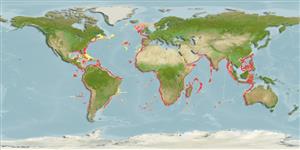Teleostei (teleosts) >
Gadiformes (Cods) >
Macrouridae (Grenadiers or rattails)
Etymology: Malacocephalus: Greek, malakos = soft + Greek, kephale = head (Ref. 45335).
More on author: Lowe.
Environment: milieu / climate zone / depth range / distribution range
Ecology
Marine; bathydemersal; non-migratory; depth range 200 - 1000 m (Ref. 1371), usually 300 - 750 m (Ref. 3587). Deep-water; 62°N - 43°S, 97°W - 124°E (Ref. 1371)
Atlantic, Indian and Pacific: Western Atlantic: Strait of Florida to Brazil, Gulf of Mexico and Caribbean Sea. Eastern Atlantic: Iceland (Ref. 12462) and Faroes to South Africa. Indian Ocean: Arabian Sea, Bay of Bengal, off Maldives and off East African coast. Western Pacific: Indonesian area and Australia. Eastern Central Pacific (Ref. 9315). Malacocephalus hawaiiensis, Malacocephalus luzonensis, and Malacocephalus nipponensis are closely related to Malacocephalus laevis and may eventually prove to represent populations of this species, if a comprehensive comparison of material from the Atlantic, Indian and Pacific oceans is done (Ref. 1371).
Size / Weight / Age
Maturity: Lm ? range ? - ? cm
Max length : 60.0 cm TL male/unsexed; (Ref. 2800); common length : 40.0 cm TL male/unsexed; (Ref. 26999)
Dorsal
spines
(total): 2;
Dorsal
soft rays
(total): 229;
Anal
spines: 0. Head uniformly scaled, including the mandibles and the ventral aspects of the snout and suborbital. Snout blunt, its tip with a conical tubercle. The trunk is short, the body tapers abruptly from behind the first dorsal fin. The caudal fin is absent.
Found on continental slopes (Ref. 1371). Utilized mainly for fishmeal and oil (Ref. 1371). In the past, fishers in the North Atlantic were reported to have used the luminescent excretion from the ventral light organ to enhance baits used for cod fishing (Ref. 1371).
Life cycle and mating behavior
Maturity | Reproduction | Spawning | Eggs | Fecundity | Larvae
Cohen, D.M., T. Inada, T. Iwamoto and N. Scialabba, 1990. FAO species catalogue. Vol. 10. Gadiform fishes of the world (Order Gadiformes). An annotated and illustrated catalogue of cods, hakes, grenadiers and other gadiform fishes known to date. FAO Fish. Synop. 125(10). Rome: FAO. 442 p. (Ref. 1371)
IUCN Red List Status (Ref. 130435)
Threat to humans
Harmless
Human uses
Fisheries: minor commercial
More information
ReferencesAquacultureAquaculture profileStrainsGeneticsElectrophoresesHeritabilityDiseasesProcessingNutrientsMass conversion
Tools
Special reports
Download XML
Internet sources
Estimates based on models
Preferred temperature (Ref.
123201): 6.1 - 13.9, mean 9.5 °C (based on 824 cells).
Phylogenetic diversity index (Ref.
82804): PD
50 = 0.5078 [Uniqueness, from 0.5 = low to 2.0 = high].
Bayesian length-weight: a=0.00129 (0.00075 - 0.00222), b=3.14 (2.99 - 3.29), in cm total length, based on LWR estimates for this species & (Sub)family-body (Ref.
93245).
Trophic level (Ref.
69278): 3.8 ±0.56 se; based on food items.
Resilience (Ref.
120179): Very Low, minimum population doubling time more than 14 years (Preliminary K or Fecundity.).
Fishing Vulnerability (Ref.
59153): Moderate vulnerability (44 of 100).
Nutrients (Ref.
124155): Calcium = 19.5 [11.4, 49.2] mg/100g; Iron = 0.413 [0.190, 0.856] mg/100g; Protein = 16.4 [14.7, 18.1] %; Omega3 = 0.211 [0.102, 0.439] g/100g; Selenium = 21.6 [8.4, 53.6] μg/100g; VitaminA = 17.4 [3.5, 83.1] μg/100g; Zinc = 0.395 [0.249, 0.636] mg/100g (wet weight);
